Introduction
Welcome to the wonderful world of Samsung tablets! As a proud owner of a Samsung tablet, you are about to experience the perfect blend of style, innovation, and functionality. Samsung tablets are well-known for their sleek designs, powerful performance, and an intuitive user interface that makes them a joy to use.
Whether you’re a first-time tablet user or upgrading from a previous model, this guide will help you get the most out of your Samsung tablet. In this article, we’ll walk you through the basics of setting up your tablet, navigating the home screen, using apps, customizing settings, and much more.
With a Samsung tablet in your hands, you’ll have access to a wide range of features and applications that cater to your needs and interests. From browsing the internet and sending emails to taking breathtaking photos and watching your favorite movies, your Samsung tablet will be your ultimate companion in both work and play.
So, get ready to embark on an exciting journey as we unravel the secrets of your Samsung tablet. Whether you use it for productivity, entertainment, or both, this guide will provide you with all the information you need to make the most of your device.
Are you ready? Let’s dive in and discover everything you need to know about using your Samsung tablet!
Getting Started
Congratulations on your new Samsung tablet! Before you dive into using your device, there are a few essential steps to get started. Let’s walk through the initial setup process:
1. Charging your tablet
The first thing you’ll want to do is ensure your tablet has enough power to get you started. Connect your tablet to the included charger and plug it into a power outlet. Once connected, you can see the charging status on the screen. It’s recommended to charge your tablet fully before using it for the first time.
2. Turning on your tablet
To turn on your Samsung tablet, simply press and hold the power button until the screen lights up. Follow the on-screen instructions to set your language, date, and time preferences.
3. Logging in or creating an account
If you already have a Google account, you can sign in with it to access the Play Store, Gmail, and various Google services. If you don’t have an account, you’ll have the option to create one during the setup process. Having a Google account is essential for downloading apps and utilizing other features of your tablet.
4. Setting up biometric security
For enhanced security and convenience, you can set up biometric authentication features such as fingerprint or facial recognition. This allows you to unlock your tablet with just a touch or a glance. Follow the prompts to enroll your biometric data and create a backup PIN or password as a fallback option.
5. Connecting to Wi-Fi
Connecting your tablet to a Wi-Fi network lets you access the internet, download apps, and browse online content. From the settings menu, select “Wi-Fi” and choose your network from the available options. If the network is password-protected, enter the correct password to establish the connection.
Once you have completed these essential setup steps, you’re ready to explore all the incredible features and capabilities of your Samsung tablet. In the next sections, we will delve deeper into various aspects of using your tablet, from navigating the home screen to customizing settings and managing apps.
Setting up your Samsung Tablet
Setting up your Samsung tablet to meet your preferences and needs is an important step in maximizing your user experience. Let’s explore some key aspects of setting up your tablet:
1. Personalizing your home screen
One of the first things you’ll want to do is customize your home screen to reflect your style and provide quick access to your favorite apps and widgets. Press and hold on an empty space on the home screen to access the customization options. From here, you can add or remove app icons, widgets, and change wallpapers to create a personalized and visually appealing interface.
2. Setting up your Samsung account
A Samsung account allows you to access exclusive services, back up your data, and sync your settings across multiple devices. To set up a Samsung account, go to the settings menu and select “Accounts and backup.” Choose “Add account” and follow the prompts to create your account or sign in if you already have one.
3. Managing app permissions
When you install apps on your Samsung tablet, you may be prompted to grant permissions for certain functions, such as accessing your camera, location, or contacts. Take a moment to review these permissions and only grant access to the apps you trust. To manage app permissions, go to the settings menu, select “Apps,” and choose the app you wish to modify permissions for.
4. Enabling biometric security
As mentioned earlier, enabling biometric security, such as fingerprint or facial recognition, adds an extra layer of protection to your tablet. Go to the settings menu and select “Biometrics and security” to configure and enable these features. Remember to set up a secure backup PIN or password in case your biometric data is not recognized.
5. Backing up your data
It’s crucial to back up your data regularly to prevent any loss in the event of accidental damage or device failure. Samsung provides various backup options, including cloud backup and syncing with third-party services. Go to the settings menu, select “Accounts and backup,” and choose the backup method that suits your needs.
By following these steps, you can ensure that your Samsung tablet is set up just the way you like it. Personalizing your home screen, setting up your Samsung account, managing app permissions, enabling biometric security, and backing up your data are essential in creating a seamless and secure user experience.
Now that your Samsung tablet is fully set up, let’s move on to exploring the various features and functions that make your tablet such a versatile and powerful device.
Navigating the Home Screen
The home screen of your Samsung tablet serves as a hub for accessing your favorite apps, widgets, and settings. By understanding how to navigate the home screen efficiently, you can effortlessly access the information and functions you need. Let’s explore some key aspects of navigating the home screen:
1. Home screen layout
When you unlock your tablet, you’ll be greeted by the home screen, which consists of multiple pages that you can swipe horizontally to navigate. Each page can be customized with app icons, folders, and widgets. By arranging your frequently used apps and widgets on the home screen, you can access them with ease.
2. App drawer
To access the complete list of apps installed on your Samsung tablet, simply locate and tap on the “App Drawer” icon on the home screen. This icon usually resembles a grid of dots or squares and is commonly located in the dock or at the center of the home screen. In the app drawer, you can view all your installed apps and swipe left or right to navigate through multiple pages.
3. Widgets
Widgets provide quick access to information or app functions directly on your home screen. To add a widget, long-press on an empty space on the home screen and select “Widgets.” Scroll through the available widget options and choose the one you want to add. Once added, you can resize and reposition the widget to suit your preference.
4. App shortcuts and folders
If you have a large number of apps on your tablet, organizing them into folders can help you stay organized and find apps more efficiently. To create a folder, long-press on an app icon and drag it on top of another app icon. The two apps will be combined into a folder. You can then name the folder and add more apps by dragging them into the folder.
5. Quick settings panel
The quick settings panel provides easy access to commonly used settings and functions. To access the quick settings panel, swipe down from the top of the screen with two fingers. From here, you can toggle Wi-Fi, adjust brightness, enable/disable airplane mode, and much more. You can also customize the quick settings panel to include the shortcuts that are most relevant to you.
By mastering the navigation of your Samsung tablet’s home screen, you can optimize your productivity and make the most out of its features. From arranging app icons and widgets to organizing apps into folders and accessing quick settings, navigating the home screen becomes second nature, allowing you to find what you need swiftly and effortlessly.
Next, we’ll delve into the exciting world of apps and explore how to download, install, and use them on your Samsung tablet.
Using Apps
Apps are at the heart of your Samsung tablet, allowing you to accomplish a wide range of tasks and enjoy various forms of entertainment. Understanding how to download, install, and use apps will help you make the most of your device’s capabilities. Let’s explore the world of apps on your Samsung tablet:
1. Downloading apps
The Samsung tablet comes preloaded with the Google Play Store, the official app store for Android devices. To download apps, open the Play Store from your app drawer and search for the app you want. Tap on the app to see more details, then click the “Install” or “Get” button to download and install the app onto your tablet.
2. Organizing apps
As you download and install more apps, it’s a good idea to organize them for easy access. You can move app icons on your home screen by pressing and holding the icon until it wiggles, then dragging it to the desired location. You can also create folders, as mentioned in the previous section, to group similar apps together.
3. Opening and closing apps
To open an app, simply tap its icon on the home screen or in the app drawer. Once an app is open, you can navigate within the app using touch gestures such as swiping, scrolling, and tapping on buttons or options. To close an app, you can either press the home button, which takes you back to the home screen, or use the recent apps button to view and swipe away the app you want to close.
4. Managing app notifications
Your Samsung tablet allows apps to send notifications for various events and updates. To manage app notifications, go to the settings menu and select “Notifications.” From here, you can customize which apps can show notifications, control the type of notifications they can send, and even block notifications from specific apps if desired.
5. Uninstalling apps
If you no longer need an app or want to free up space on your tablet, you can uninstall unused apps. To uninstall an app, go to the settings menu, select “Apps,” and choose the app you wish to uninstall. Tap on the “Uninstall” button to remove the app from your tablet.
By confidently navigating through the world of apps on your Samsung tablet, you can discover new tools, entertainment, and functionalities that enhance your tablet experience. Whether it’s productivity apps, social media platforms, or games, the possibilities are endless when it comes to expanding your app collection.
Next, we’ll dive into the settings of your Samsung tablet and explore how customization options can make your device truly your own.
Customizing Settings
One of the great advantages of owning a Samsung tablet is the ability to customize its settings to align with your personal preferences and needs. From adjusting display settings to configuring accessibility options, let’s explore some key ways to customize the settings on your Samsung tablet:
1. Display settings
Go to the settings menu and select “Display” to access a range of customization options for your tablet’s screen. You can adjust brightness levels, change the screen timeout duration, enable or disable auto-rotate, and even customize the font size and style to suit your reading comfort.
2. Sound and notification settings
To personalize the audio experience on your Samsung tablet, navigate to the settings menu, choose “Sound and vibration,” and explore various options. You can adjust the volume levels, select notification sounds, enable vibration, and even set a custom ringtone for calls and notifications.
3. Accessibility settings
If you have specific accessibility needs, Samsung tablets provide a range of options to make your device more user-friendly. In the settings menu, select “Accessibility” to enable features such as color inversion, magnification gestures, and text-to-speech. These accessibility options can greatly enhance the usability and accessibility of your tablet.
4. Privacy and security settings
Protecting your personal information and ensuring the security of your Samsung tablet is essential. In the settings menu, select “Security,” where you can set up screen locks, enable secure folder options for sensitive files, and manage app permissions to control what information apps can access on your device.
5. Advanced settings
If you’re an advanced user or tech-savvy individual, exploring the advanced settings on your Samsung tablet opens up even more customization options. From developer options, which allow you to fine-tune system settings, to battery optimization and storage management, these advanced settings let you optimize your tablet’s performance to suit your exact requirements.
By customizing the settings on your Samsung tablet, you can tailor the device to meet your individual preferences and optimize its performance. From adjusting display and sound settings to configuring accessibility and privacy options, take the time to explore the various customization options available to maximize your tablet experience.
In the next sections, we will delve into the practical aspects of using your Samsung tablet, including managing Wi-Fi and data connections, browsing the internet, sending and receiving emails, and more.
Managing Wi-Fi and Data Connections
Staying connected to the internet is crucial for making the most out of your Samsung tablet’s features and capabilities. Whether you’re accessing the web, downloading apps, or staying connected with friends and family, you’ll need to manage your Wi-Fi and data connections effectively. Let’s explore how to do so:
1. Connecting to Wi-Fi
To connect your Samsung tablet to a Wi-Fi network, go to the settings menu and select “Wi-Fi.” Toggle the Wi-Fi switch to the “On” position and wait for the tablet to scan for available networks. Once the network you want to connect to appears, tap on it and enter the password if required. Your tablet will then connect to the Wi-Fi network, providing you with high-speed internet access.
2. Managing saved Wi-Fi networks
If you frequently connect to specific Wi-Fi networks, you can save their credentials on your tablet for automatic connection in the future. To manage saved Wi-Fi networks, go to the settings menu, select “Wi-Fi,” and tap on the gear icon next to the desired network. From here, you can forget the network, modify its settings, or choose to auto-connect whenever the network is within range.
3. Enabling and disabling mobile data
In addition to Wi-Fi connectivity, you can also use mobile data to access the internet when you’re not within Wi-Fi range. To enable or disable mobile data on your Samsung tablet, go to the settings menu and select “Connections.” Tap on “Data usage” and toggle the “Mobile data” switch to turn it on or off. Please note that mobile data usage may incur additional charges depending on your cellular plan.
4. Managing data usage
If you have a limited data plan, you can monitor and manage your data usage to avoid surpassing your allocation. In the settings menu, select “Connections” and tap on “Data usage.” From here, you can view your data usage, set billing cycles, enable data-saving options, and even set data usage limits with warnings to keep track of your consumption.
5. Using Wi-Fi calling and hotspot
Your Samsung tablet offers additional features such as Wi-Fi calling and Wi-Fi hotspot functionality. Wi-Fi calling allows you to make and receive calls over a Wi-Fi network, providing improved call quality and coverage. The Wi-Fi hotspot feature enables you to share your tablet’s internet connection with other devices. Both features can be found in the settings menu under “Connections” and can be enabled and configured according to your needs.
By effectively managing your Wi-Fi and data connections, you can ensure a seamless and uninterrupted internet experience on your Samsung tablet. Whether you’re accessing the internet for leisure, work, or staying connected with loved ones, a reliable and optimized connection is essential.
In the upcoming sections, we will explore browsing the internet, sending and receiving emails, managing contacts, and utilizing other communication features on your Samsung tablet.
Browsing the Internet
With your Samsung tablet in hand, you have the power to browse the internet and explore a world of information, entertainment, and communication. Whether you want to search for information, stream videos, or connect with friends on social media, let’s dive into the essentials of browsing the internet on your tablet:
1. Opening the web browser
Your Samsung tablet comes equipped with a preinstalled web browser that allows you to surf the internet. Locate the web browser icon, usually labeled as “Internet” or “Chrome,” on your home screen or app drawer. Tap the icon to open the browser and begin your online journey.
2. Navigating web pages
Once the web browser is open, you can enter a website URL directly into the address bar at the top of the screen. You can also use search engines like Google by entering keywords or phrases in the search bar. Use familiar touch gestures, such as swiping up and down to scroll through pages and pinch-to-zoom to adjust the page zoom level.
3. Bookmarks and tabs
To save your favorite websites for quick access, you can bookmark them. When you’re on a webpage you’d like to bookmark, tap the “Menu” button in the web browser and select “Bookmark.” You can also open multiple web pages in separate tabs for easier navigation. To open a new tab, tap the tab icon in the browser toolbar and select “New tab.
4. Managing browser settings
Customizing the settings of your web browser can enhance your browsing experience. Explore the browser settings, accessible through the menu button, to adjust preferences such as search engine, privacy settings, font size, and pop-up blocker. You can also enable features like data saver mode to reduce data usage when browsing on a mobile network.
5. Security and privacy
When browsing the internet, it’s essential to prioritize your security and privacy. Keep your tablet’s software up to date, use secure and trusted websites, and be cautious when sharing personal information online. It’s advisable to regularly clear your browsing history, cookies, and cache to maintain your privacy and keep your tablet running smoothly.
Browsing the internet on your Samsung tablet opens up a world of possibilities. From accessing information, staying up to date with the latest news, to enjoying streaming platforms and connecting with others, the web browser on your tablet is your gateway to the online world.
In the next sections, we will explore how to send and receive emails, manage your contacts, and utilize other communication features available on your Samsung tablet.
Sending and Receiving Emails
Email communication is an essential part of staying connected in today’s digital world. With your Samsung tablet, you can easily send, receive, and manage your emails on the go. Let’s explore how to make the most of your email experience on your tablet:
1. Setting up your email account
To get started, open the email app on your Samsung tablet. If you’re setting up your email account for the first time, you will be prompted to enter your email address and password. The app will automatically attempt to configure the settings for popular email providers. If you’re using a less common email service, you may need to manually enter the email server settings.
2. Composing and sending emails
To compose a new email, tap on the “Compose” button within the email app. Enter the recipient’s email address in the “To” field, add a subject line, and then write your message in the body of the email. You can also attach files, such as documents or photos, to your email if needed. Once you’re satisfied with your email, tap on the send button to send it out.
3. Managing your inbox
Your email app will display your inbox, where you can see all your received emails. You can swipe down to refresh the inbox and check for new emails. To open an email, simply tap on it. You can archive, delete, or mark emails as unread by selecting the appropriate options from the email toolbar. Use the search function within the app to find specific emails from your inbox.
4. Organizing emails with folders and labels
To keep your emails organized, you can create folders or labels within your email app. These allow you to categorize and sort your emails based on specific criteria. To create a folder or label, go to the email app’s settings and explore the options to customize the organization of your emails. You can move emails into folders or assign labels to them for easy reference.
5. Managing multiple email accounts
If you have multiple email accounts, such as personal and work accounts, you can set them up within the email app on your Samsung tablet. By adding and managing multiple accounts, you can access and manage all your emails in one place. To add a new email account, go to the email app’s settings and select “Add Account.”
With the email capabilities of your Samsung tablet, you can stay connected and organized wherever you go. Whether it’s for personal or professional purposes, the email app on your tablet provides a seamless and efficient way to send, receive, and manage your electronic communications.
In the upcoming sections, we will explore how to manage contacts, take and edit photos, watch videos, and listen to music on your Samsung tablet.
Managing Contacts
Your Samsung tablet allows you to easily manage your contacts, ensuring that your important contacts’ information is accessible and up to date. From adding new contacts to grouping them and syncing them across devices, let’s explore how to efficiently manage your contacts:
1. Adding new contacts
To add a new contact to your Samsung tablet, open the Contacts app from your app drawer or home screen. Tap on the “Add” or “New” button, and enter the contact’s details, such as name, phone number, email address, and any other relevant information. You can also assign a photo to the contact for visual identification.
2. Grouping contacts
If you have a large number of contacts or want to categorize them, grouping contacts is a useful feature. You can create contact groups, such as friends, family, or work, to easily locate and manage specific sets of contacts. To create a contact group, navigate to the Contacts app, go to the “Groups” tab, and select “Create group.”
3. Syncing contacts across devices
If you have multiple devices, such as a smartphone or computer, you can sync your contacts across all your devices for seamless access and updates. To enable contact syncing, go to the settings menu, select “Accounts and backup,” and choose your Google account or any other account associated with your contacts. Ensure that the “Contacts” option is toggled on to sync your contacts.
4. Importing and exporting contacts
If you have contacts saved in other accounts or in a different format, you can import them to your Samsung tablet. Navigate to the Contacts app, go to the settings menu, and select “Import/Export contacts.” From here, you can select the desired import or export method, such as importing contacts from a SIM card, exporting contacts to a storage location, or importing contacts from another account.
5. Updating and deleting contacts
Periodically reviewing and updating your contacts is important to ensure that the information remains accurate and relevant. To update a contact, open the Contacts app, find the contact you want to edit, and tap on it. From here, you can modify any information associated with the contact. If you need to delete a contact, open the contact’s details and select the delete option, usually represented by a trash bin icon.
Managing contacts on your Samsung tablet allows you to keep your connections organized and accessible. By adding new contacts, grouping them, syncing them across devices, and keeping the information up to date, you can easily stay in touch with the important people in your life.
Next, we will explore how to capture and edit photos, watch videos, and listen to music on your Samsung tablet.
Taking and Editing Photos
Your Samsung tablet is equipped with a powerful camera that allows you to capture beautiful photos and preserve special moments. Whether you’re a photography enthusiast or simply love capturing memories, let’s explore how to take and edit photos on your tablet:
1. Capturing photos
To take a photo, open the camera app on your Samsung tablet. Position your tablet to frame the desired shot and tap the capture button, usually represented by a camera icon. You can also use various shooting modes available in the camera app, such as panorama or beauty mode, to enhance your photos.
2. Adjusting camera settings
Before taking photos, you can customize various camera settings to suit your preferences. Explore the options within the camera app to adjust settings such as exposure, white balance, focus mode, and flash modes. It’s worth experimenting with these settings to achieve the desired results based on the lighting conditions and your photographic goals.
3. Reviewing and organizing photos
Once you have taken photos, you can review them within the camera app or in the Gallery app on your Samsung tablet. From the camera app, simply swipe from left to right to access the preview of your most recent photo. In the Gallery app, you can view all your saved photos, organize them into albums, and even edit them further.
4. Editing photos
Your Samsung tablet offers impressive editing capabilities to enhance and personalize your photos. In the Gallery app, select a photo and tap on the edit button. From here, you can apply filters, adjust brightness, contrast, and saturation, crop or straighten the image, and apply various other effects to make your photos truly standout.
5. Sharing and storing photos
Once you have captured and edited your photos, you can easily share them with friends and family. Select the desired photo in the Gallery app, tap on the share button, and choose the sharing method, such as email, messaging apps, or social media platforms. Additionally, it’s essential to regularly back up your photos to cloud storage or other external storage options to ensure their safety and longevity.
Taking and editing photos on your Samsung tablet allows you to unleash your creativity and capture meaningful moments. With the powerful camera and versatile editing tools available at your fingertips, you can transform ordinary photos into extraordinary works of art.
In the next sections, we will explore how to watch videos, listen to music, and utilize productivity apps on your Samsung tablet.
Watching Videos and Listening to Music
With your Samsung tablet, you have a portable entertainment center that allows you to watch videos and listen to music wherever you go. Whether you want to relax with your favorite TV shows or enjoy your music library, let’s explore how to make the most of your tablet for video streaming and music playback:
1. Video streaming
Your Samsung tablet provides various options for video streaming. You can download streaming apps such as Netflix, YouTube, or Amazon Prime Video from the Google Play Store. Simply open the app, sign in to your account, and explore a wide range of movies, TV shows, and other video content. You can also cast your tablet’s screen to a compatible TV for a larger viewing experience.
2. Music playback
To enjoy music on your Samsung tablet, you can use the preinstalled Music app or download a music streaming app like Spotify or Apple Music. These apps allow you to stream music from a vast catalog or play music stored locally on your tablet. Create playlists, explore curated playlists, and discover new artists and genres to enhance your music listening experience.
3. Managing your media library
The Gallery app on your Samsung tablet allows you to store and manage all your multimedia files, including videos and music. Use the app to organize your media into albums or playlists for easy access. You can also edit metadata, such as album covers and song titles, to keep your media library organized and visually appealing.
4. Optimizing video and audio settings
Your Samsung tablet provides settings to optimize the video and audio playback experience. For video settings, you can adjust the display mode, screen brightness, and video playback quality within the streaming app or the tablet’s settings menu. Similarly, for audio settings, you can enable or disable sound enhancements, adjust equalizer settings, and connect Bluetooth headphones or speakers for a more immersive sound experience.
5. Offline playback
If you anticipate being in an area without internet access, many streaming apps offer the option to download videos or music for offline playback. Check the settings within the respective app to see if this feature is available. Downloading content in advance ensures that you can enjoy your favorite videos and music even when an internet connection is not available.
Your Samsung tablet is a versatile device for entertainment on the go. Whether you’re streaming videos, listening to music, or managing your media library, the tablet offers a comprehensive multimedia experience that caters to your preferences and keeps you entertained wherever you are.
In the next sections, we will explore how to stay organized and productive with apps available on your Samsung tablet.
Keeping Track of Your Schedule
With the help of your Samsung tablet, you can easily stay organized and manage your schedule effectively. Whether it’s tracking appointments, setting reminders, or syncing your calendar across devices, let’s explore how to make the most of your tablet for scheduling and time management:
1. Calendar app
Your Samsung tablet comes preloaded with a Calendar app that allows you to create events, set reminders, and manage your schedule. Open the Calendar app from your app drawer or home screen, and you’ll be able to view your events by day, week, or month. Tap on a specific date to add an event or reminder.
2. Creating events
To create a new event in the Calendar app, tap on the desired date and time slot. Enter the event details, such as the title, location, and duration. You can also set reminders to ensure that you receive notifications before important events. Additionally, you can invite others to the event by adding their email addresses.
3. Setting reminders
Reminders are a helpful feature to ensure you don’t miss important tasks and appointments. To set a reminder, open the Calendar app and tap on the desired date and time. Instead of creating an event, select “Reminder” and enter the details. You can customize the reminder time and even set it to repeat if necessary.
4. Syncing with other devices
If you have multiple devices, such as a smartphone or computer, you can sync your calendar across all devices to access your schedule from anywhere. Go to the settings menu on your Samsung tablet, select “Accounts and backup,” and choose your Google account. Ensure that the “Calendar” option is toggled on to sync your calendar events across devices.
5. Third-party calendar apps
In addition to the preloaded Calendar app, there are various third-party calendar apps available on the Google Play Store that offer additional features and customization options. Explore options like Google Calendar, Microsoft Outlook, or other popular calendar apps to find one that suits your preferences and integrates well with your tablet.
Your Samsung tablet can be a valuable tool for keeping track of your schedule and staying organized. Utilize the Calendar app, set reminders, sync your calendar across devices, and consider exploring additional calendar apps to find the one that meets your specific needs and enhances your productivity.
In the upcoming sections, we will explore how to use productivity apps on your Samsung tablet to further enhance your efficiency and effectiveness.
Using Apps for Productivity
Your Samsung tablet offers a variety of productivity apps to help you stay organized, efficient, and focused on your tasks. From note-taking and document editing to task management and collaboration, let’s explore some of the key productivity apps available on your tablet:
1. Note-taking apps
Note-taking is made easy with apps like Samsung Notes or Evernote. These apps allow you to jot down ideas, create to-do lists, and even sketch or draw. You can organize your notes into categories or notebooks and access them across devices. With features like handwriting recognition and voice recordings, note-taking becomes a seamless part of your productivity routine.
2. Office suite apps
For document creation and editing, the familiar Microsoft Office suite, including Word, Excel, and PowerPoint, is available for your Samsung tablet. These apps enable you to create and modify documents, spreadsheets, and presentations on the go. With cloud sync options, you can seamlessly collaborate with others and access your files across devices.
3. Task management apps
To help you stay organized and manage your tasks effectively, task management apps like Todoist, Microsoft To Do, or Google Tasks are invaluable. These apps allow you to create tasks, set due dates, prioritize, and even assign tasks to others. You can create lists and categories, set reminders, and track your progress to ensure that nothing falls through the cracks.
4. Cloud storage and file management
Cloud storage apps like Google Drive, Dropbox, or OneDrive provide you with a secure and convenient way to store and access your files from anywhere. With these apps, you can easily upload, download, and share files. With automatic syncing, your files are always up to date, and you can switch seamlessly between your tablet and other devices.
5. Collaboration and communication
Efficient collaboration and communication are vital for productivity. Apps like Microsoft Teams, Slack, or Google Meet offer powerful tools for team communication, video conferencing, and file sharing. With these apps, you can stay connected with colleagues, collaborate on projects, and conduct virtual meetings, whether you’re in the office or on the go.
Your Samsung tablet can be a valuable tool for boosting your productivity. By utilizing note-taking apps, office suite apps, task management apps, cloud storage, and collaboration apps, you can stay organized, streamline your work, and collaborate effectively with others. Consider exploring these apps and incorporating them into your daily workflow to enhance your productivity and efficiency.
In the upcoming sections, we will explore how to transfer files to and from your tablet and troubleshoot common issues that may arise.
Transferring Files to and from your Tablet
Transferring files to and from your Samsung tablet is essential for accessing and sharing content across different devices. From transferring photos and documents to syncing music and videos, let’s explore some of the methods you can use to easily transfer files:
1. USB connection
One of the simplest ways to transfer files is by using a USB connection between your tablet and a computer. Connect your tablet to the computer using a USB cable. On your tablet, pull down the notification panel and select the option for file transfer or media transfer. Your computer should recognize your tablet as an external storage device, allowing you to drag and drop files to transfer them.
2. Cloud storage services
Cloud storage services like Google Drive, Dropbox, or OneDrive provide a convenient way to transfer files between your tablet and other devices. Simply upload the files from your tablet to the cloud storage service, and then access them from your computer or other devices using the same cloud storage account. This method allows for easy syncing and sharing of files across multiple devices.
3. Email or messaging apps
If you have a small file that needs to be transferred, you can send it as an attachment via email or messaging apps. Compose a new email or message, attach the file, and send it to yourself or the desired recipient. You can then access your email or message on your computer or another device and download the attachment for further use.
4. Bluetooth connection
For wireless file transfers, you can use the Bluetooth feature on your tablet. Enable Bluetooth on both your tablet and the device you want to transfer files to. Pair the devices by following the prompts, and then you can select and send files from your tablet to the paired device. Keep in mind that Bluetooth transfer may be slower than other methods, especially for larger files.
5. App-specific file sharing
Some apps offer built-in file sharing capabilities. For example, photo editing apps or note-taking apps may allow you to export or share files directly from the app to other devices or applications. Explore the sharing options within the specific app you are using, and follow the instructions provided to initiate the file transfer.
Transferring files to and from your Samsung tablet is important for accessing and sharing content seamlessly. Whether it’s using a USB connection, utilizing cloud storage services, sending files through email or messaging apps, establishing a Bluetooth connection, or leveraging app-specific file sharing features, you have several options to choose from based on your specific needs and preferences.
In the next section, we will address common issues that you may encounter while using your Samsung tablet and provide troubleshooting tips to resolve them.
Troubleshooting Common Issues
While your Samsung tablet is a reliable device, you may encounter some common issues from time to time. Here are some troubleshooting tips to help you address and resolve these issues:
1. Device freezing or unresponsive
If your tablet becomes unresponsive or freezes, try performing a soft reset. Press and hold the power button for about 10-15 seconds until the device restarts. This can help resolve temporary software glitches or freeze-ups.
2. Battery draining quickly
If you notice that your tablet’s battery is draining quickly, check for battery-draining apps. Go to the settings menu, select “Battery,” and review the app usage. You can close unnecessary background apps or adjust settings to reduce battery consumption, such as reducing screen brightness or enabling power-saving modes.
3. Slow performance
If your tablet is running slowly, there are a few steps you can take. Clearing the cache can help improve performance. Go to the settings menu, select “Apps,” choose the app you want to clear the cache for, and tap on “Clear cache.” Additionally, uninstalling unused apps, restarting your tablet regularly, and ensuring sufficient storage space can also help improve performance.
4. Wi-Fi or connectivity issues
If you’re experiencing Wi-Fi or connectivity issues, start by turning off Wi-Fi and turning it back on. If the problem persists, try restarting your router. You can also forget the Wi-Fi network on your tablet and reconnect to it. If the issue continues, check for software updates for both your tablet and the router, as updating the software can often resolve connectivity issues.
5. App crashes or errors
If an app on your tablet is crashing or showing error messages, try clearing the app cache and data. Go to the settings menu, select “Apps,” choose the problematic app, and tap on “Clear cache” and “Clear data.” You can also try uninstalling and reinstalling the app from the Google Play Store to fix any issues caused by a faulty installation.
If the above troubleshooting steps do not resolve the issue, you may consider contacting Samsung support or visiting a service center for further assistance. They can provide specialized guidance and solutions to resolve more complex issues with your Samsung tablet.
By implementing these troubleshooting tips, you can quickly address common issues and ensure a smooth and enjoyable experience with your Samsung tablet.
Now that we have addressed common issues, we conclude our guide on using your Samsung tablet. We hope this information has been helpful in enabling you to make the most of your device and enjoy all the features and functionalities it offers. Happy exploring and have a great time with your Samsung tablet!
Conclusion
Congratulations! You have now reached the end of our comprehensive guide on how to use your Samsung tablet. We have covered a wide range of topics, from setting up your tablet to exploring its features, customizing settings, managing connectivity, using apps, and troubleshooting common issues.
Your Samsung tablet is a powerful and versatile device that enables you to stay productive, connected, and entertained. With its sleek design, intuitive interface, and vast app ecosystem, it offers endless possibilities for work and play.
Remember to make the most of the various customization options available, personalize your home screen, and explore the wide array of apps suitable for your needs. Whether you are using it for note-taking, document editing, task management, or multimedia consumption, your tablet provides an immersive and user-friendly experience.
Should you encounter any issues along the way, refer back to the troubleshooting section for helpful tips and solutions. Additionally, consider reaching out to Samsung support or visiting a service center for further assistance.
We hope this guide has boosted your confidence in using your Samsung tablet and provided you with the knowledge to navigate its features efficiently. Whether you’re a beginner or an experienced user, we believe that you now have the tools and understanding to make the most of your device.
Now go forth, explore, and enjoy all the exciting possibilities offered by your Samsung tablet. From staying organized, productive, and connected, to capturing memories, watching videos, and listening to music, your tablet is your gateway to a world of endless opportunities.
Thank you for choosing Samsung and enjoy your incredible journey with your Samsung tablet!

























